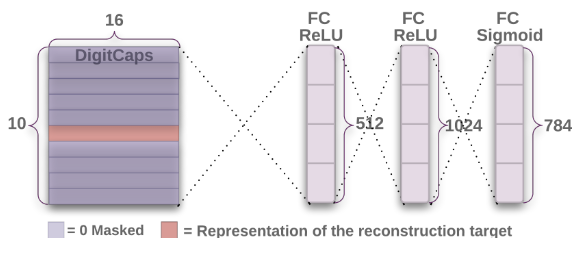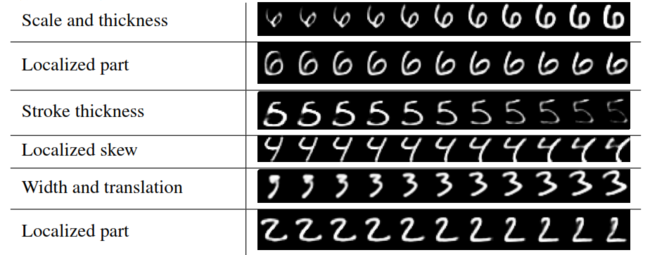Dynamic Routing Between Capsules STAT946: Difference between revisions
| Line 108: | Line 108: | ||
=== Agreement === | === Agreement === | ||
The final step of a routing iteration is to form an routing agreement <math> | The final step of a routing iteration is to form an routing agreement <math>a_{ij}</math> | ||
\begin{align} | \begin{align} | ||
Revision as of 07:33, 2 April 2018
Presented by
Yang, Tong(Richard)
Introduction
Hinton's Critiques on CNN
Four arguments against pooling
- It is a bad fit to the psychology of shape perception: It does not explain why we assign intrinsic coordinate frames to objects and why they have such huge effects.
- It solves the wrong problem: We want equivariance, not invariance. Disentangling rather than discarding.
- It fails to use the underlying linear structure: It does not make use of the natural linear manifold that perfectly handles the largest source of variance in images.
- Pooling is a poor way to do dynamic routing: We need to route each part of the input to the neurons that know how to deal with it. Finding the best routing is equivalent to parsing the image.
Equivariance
- Without the sub-sampling, convolutional neural nets give "place-coded" equivariance for discrete translations.
Two types of equivariance
Place-coded equivariance
If a low-level part moves to a very different position it will be represented by a different capsule.
Rate-coded equivariance
If a part only moves a small distance it will be represented by the same capsule but the pose outputs of the capsule will change.
Higher-level capsules have bigger domains so low-level place-coded equivariance gets converted into high-level rate-coded equivariance.
== Extrapolating shape recognition to very different viewpoints
- Current neural net wisdom:
- Learn different models for different viewpoints.
- This requires a lot of training data.
- A much better approach:
- The manifold of images of the same rigid shape is highly non-linear in the space of pixel intensities.
- Transform to a space in which the manifold is globally linear
Dynamic Routing
In the second section of this paper, authors give a mathematical representations for two key features in routing algorithm in capsule network, which are squashing and agreement. The general setting for this algorithm is between two arbitrary capsules i and j. Capsule j is assumed to be an arbitrary capsule from the first layer of capsules, and capsule i is an arbitrary capsule from the layer below. The purpose of routing algorithm is generate a vector output for routing decision between capsule j and capsule i. Furthermore, this vector output will be used in the decision for choice of dynamic routing.
Routing Algorithm
The routing algorithm is as the following:

In the following sections, each part of this algorithm will be explained in details.
Log Prior Probability
[math]\displaystyle{ b_{ij} }[/math] represents the log prior probabilities that capsule i should be coupled to capsule j, and updated in each routing iteration. As line 2 suggests, the initial values of [math]\displaystyle{ b_{ij} }[/math] for all possible pairs of capsules are set to 0. In the very first routing iteration, [math]\displaystyle{ b_{ij} }[/math] equals to zero. For each routing iteration, [math]\displaystyle{ b_{ij} }[/math] gets updated by the value of agreement, which will be explained later.
Coupling Coefficient
[math]\displaystyle{ c_{ij} }[/math] represents the coupling coefficient between capsule j and capsule i. It is calculated by applying the softmax function on the log prior probability [math]\displaystyle{ b_{ij} }[/math]. The mathematical transformation is shown below (Equation 3 in paper):
\begin{align} c_{ij} = \frac{exp(b_ij)}{\sum_{k}exp(b_ik)} \end{align}
[math]\displaystyle{ c_{ij} }[/math] are served as weights for computing the weighted sum and probabilities. Therefore, as probabilities, they have the following properties:
\begin{align} c_{ij} \geq 0, \forall i, j \end{align}
and,
\begin{align} \sum_{i,j}c_{ij} = 1, \forall i, j \end{align}
Predicted Output from Layer Below
[math]\displaystyle{ u_{i} }[/math] are the output vector from capsule i in the lower layer, and [math]\displaystyle{ \hat{u}_{j|i} }[/math] are the input vector for capsule j, which are the "prediction vectors" from the capsules in the layer below. [math]\displaystyle{ \hat{u}_{j|i} }[/math] is produced by multiplying [math]\displaystyle{ u_{i} }[/math] by a weight matrix [math]\displaystyle{ W_{ij} }[/math], such as the following:
\begin{align} \hat{u}_{j|i} = W_{ij}u_i \end{align}
where [math]\displaystyle{ W_{ij} }[/math] encodes some spatial relationship between capsule j and capsule i.
Capsule
By using the definitions from previous sections, the total input vector for an arbitrary capsule j can be defined as:
\begin{align} s_j = \sum_{i}c_{ij}\hat{u}_{j|i} \end{align}
which is a weighted sum over all prediction vectors by using coupling coefficients.
Squashing
The length of [math]\displaystyle{ s_j }[/math] is arbitrary, which is needed to be addressed with. The next step is to convert its length between 0 and 1, since we want the length of the output vector of a capsule to represent the probability that the entity represented by the capsule is present in the current input. The "squashing" process is shown below:
\begin{align} v_j = \frac{||s_j||^2}{1+||s_j||^2}\frac{s_j}{||s_j||} \end{align}
Notice that "squashing" is not just normalizing the vector into unit length. In addition, it does extra non-linear transformation to ensure that short vectors get shrunk to almost zero length and long vectors get shrunk to a length slightly below 1. The reason for doing this is to make decision of routing, which is called "routing by agreement" much easier to make between capsule layers.
Agreement
The final step of a routing iteration is to form an routing agreement [math]\displaystyle{ a_{ij} }[/math]
\begin{align} a_{ij} = v_{j}\hat{u}_{j|i} \end{align}
CapsNet Architecture

How many routing iteration to use?
In appendix A of this paper, the authors have shown the empirical results from 500 epochs of training at different choice of routing iterations. According to their observation, more routing iterations increases the capacity of CapsNet but tends to bring additional risk of overfitting. Moreover, CapsNet with routing iterations less than three are not effective in general. As result, they suggest 3 iterations of routing for all experiments.
Decoder

Regularization Method: Reconstruction

MINST
Interpretation of Each Capsule
